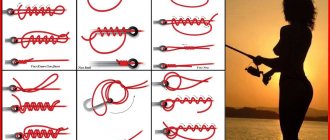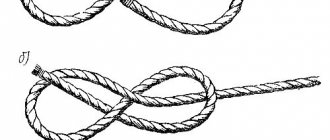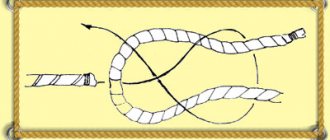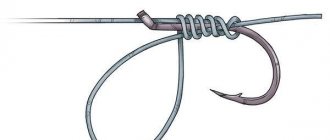The Palomar knot is a simple and reliable way to tie eye hooks, spinning lures and swivels to any type of fishing line (monofilament, braid and fluorocarbon). But the knot is not suitable for hooks with a spatula. The main advantage is the ease of knitting, one of the leaders in strength, and does not injure the fishing line on the edge of the hook eye.
There are 5 types of fishing knot “Palomar”, each has pros and cons, and some are completely meaningless. We will look at the most common options and tell you which knot is best to use on monofilament, fluorocarbon and braid and how to knit each of them correctly.
Palomar knot tying animation
| Fishing knot | Line type | monofilament | Network |
| Classic Palomar (1 hole in the eye, 1 tie) | All types | Any | 0.05-0.3 or more |
| Double Palomar (1 eyelet pass, 2 tie-downs) | All types | < 0.2 | 0.05-0.3 or more |
| Double Palomar alternative (2 passes into the eye, 1 tie) | All types (thin monofilament only) | < 0.12 | 0.05-0.12 |
| Triple Palomar (1 eyelet pass and 3 tie-downs) | All types | < 0.15 | 0.05-0.3 or more |
| Triple Palomar alternative (3 passes into the eye and 1 tie) | Only on braid or large hooks | < 0.08 | 0.05-0.12 |
Advantages
- Easy knitting. If you have a fishing line with a diameter of less than 0.25 mm and a hook larger than No. 8 according to international numbering, then tying is very easy. The difficulty begins when you have small, narrow eyes on a hook or spinning bait, or if you use thick fishing line (0.3 mm or more).
- Reliability. This fishing knot is very similar in structure to the Figure Eight, which means it is also very durable.
- Suitable for tying spinning lures , including drop-shot rigs.
What fishing knots are most often used?
To attach gear, fishermen use a huge number of different knots . And of course, every fisherman has his own favorite and repeatedly tested method of knitting.
It is worth noting that for thin and thick fishing lines, manufacturers recommend using different types of connections. Often, when purchasing a fishing line, you can read recommendations on its packaging, thanks to which the angler can independently determine which type is more appropriate to use for a given product.
So, let's try to list the most popular knots for fishing lines:
- Palomar node.
- Clinch knot.
- Double Clinch Knot.
As we said earlier, there are many knots used for weaving on thick or thin fishing line. However, in order not to get confused in this variety, we will discuss in more detail only the most popular of them.
Flaws
- Quick waste of line.
- You need a thin line or a large eyelet, otherwise it is difficult to tie even the classic version, and a double or triple Palomar is impossible.
- Not suitable for spatula hooks. For knitting you need an eyelet.
| monofilament | Braided cord | Fluorocarbon |
| It is possible, with a thickness of less than 0.3 mm and knitting the classic version. | Fits good. Tie any type of Palomar if the thickness of the eye of the bait or hook allows. | It is possible, with a thickness of up to 0.3 mm and knitting classic and alternative options, but not the usual double and triple Palomars. Fluorocarbon is too stiff for many wraps. |
How to tie a Palomar knot on a hook
Instructions for tying a single knot, but the diagram shows modifications to double and triple.
- Thread the fishing line into the eye of the hook from the inside and pull it out 15 cm.
- Then thread the end of the fishing line in the opposite direction, so that a loop sticks out from the inside of the hook.
- Now take the loop in one hand, and the other two sections of the fishing line in the other and intertwine as shown in the diagram (regular knot). For double Palomar - make 2 weaves, for triple - 3.
- Insert the hook into the loop and push it further away.
- Start tightening the knot, holding it above the hook. It is important that the loose parts of the knot do not touch the eye, and also be sure to wet the knot before final tightening.
- Pull the main line as hard as possible, and then cut off the extra piece sticking out from the knot (2 mm from the base, no closer).
Single Palomar
Double Palomar
Triple Palomar
Video instructions for tying the Palomar knot:
Replaceable units
Palomar is a fairly reliable knot, however, other types can be used to assemble the equipment, which are also easy to knit and withstand jerks well. These include the following types:
- Uni node. This type of knot is suitable for fixing hooks with a small eye diameter and swivels on fishing line. This variety does not require the use of a double thread: you need to thread the tip into the eye, make a loop, wrap the end of the thread around the main line and pass it into the created second loop with several turns. This knot is quite complex and requires experience in tying, but it is quite strong.
- Clinch knot. This variety is suitable for braided thread and classic fishing line. The tip is threaded into the eye, then the main fishing line is wrapped around it for 5-6 turns, the end of the thread is passed into the resulting small loop and pulled through a large loop, after which it is tightened.
- Sliding double knot. This knot is optimal for tying fishing lines of various thicknesses; it is used for fluorocarbon threads. Knitting a double requires skill, so beginners rarely resort to using it.
Regardless of the choice of unit design, it is important to choose the right devices and fasten them according to all the rules, only then can you be confident in the quality of the fishing equipment. https://www.youtube.com/embed/wc7C_wmgcRk
Knitting a double Palomar
Abroad, it was the alternative version of the knot that gained popularity due to the increased strength of the braid when knitting on large hooks. In the conditions of the CIS countries, it is ideal for trolling, for catching catfish and other large fish.
The knot repeats the pattern of the classic single Palomar, but at the beginning the line is threaded through the ring not 1, but 3 times in the same direction. It turns out 3 rings that enhance the strength of the knot.
Alternative triple Palomar
Where to use?
- Tie on any spinning baits, spoons, jig heads, wobblers, flies, sinkers, swivels, etc., and a leash.
- Hooks with an eye.
- Drop shot rig. Palomar is well suited for a drop shot; do not cut off the free end of the fishing line, but thread it through the eye again and tie a sinker half a meter from the hook. See the diagram.
Palomar knot in drop-shot rig
Alternative tying methods
The palomar knot has been tested by time and by many anglers; it is characterized by ease of knitting and maintaining the strength of the fishing line. This unit is very convenient to use when fishing, and even at night when you don’t have a fishing light.
It is quite difficult to forget the correct knitting pattern for such a knot. It is easy to implement and can be called relatively universal. After all, it will do an excellent job of attaching spinners, flies, hooks, swivels and other accessories.
But the classic knot pattern cannot always be used, so anglers have modernized it and made some changes that allow you to tie a double or triple palomar knot for braid, for drop-shot rigs and many others.
For braid
Tying a classic knot requires a lot of braid, which not everyone can afford. Therefore, anglers have developed a slightly different option that allows them to save a little length of the free end.
The main difference, which helps save braid, is that the loop is not passed through the eye of the swivel, but through the free end of the fishing line. In this case, a little bit of the knot’s safety margin is lost, but fishing line is saved.
For intermediate baits such as drop-shots or Carolina rigs, such a knot will not work. For other types of connections, it is perfect; despite its primitiveness, the palomar knot for braiding is quite strong.
For drop shot
A very interesting way of tying a knot was invented by anglers who prefer to fish with a drop-shot rig. Very often it is necessary to use alternative methods of tying a knot for the same gear. The entire tying sequence follows the classical pattern, only the last loop is tightened against the fore-end. The hook will not move along the fishing line, but will receive additional fixation.
Very often, anglers use this type of installation when fishing on a feeder, when it is necessary to firmly fix the hook. Experiment and you will decide which node option is right for you.
Triple palomar knot
In addition to the classic one, there is also a triple palomar knot, which is one of the most popular varieties. True, it is unlikely that you will be able to tie a hook with it, since you will have to thread the fishing line through the eye 6 times (in the case of a double knot - 4). But for tying large hooks it will be indispensable, since its strength is about 85%.
Knitting pattern
- Fold the free end of the fishing line in half;
- Pass the double end of the fishing line through the eye of the swivel;
- Now repeat the previous step two more times;
- Just above the swivel you need to tie a single knot;
- Now you need to pull the swivel into the resulting loop;
- Now you need to put a loop between the spinner and the resulting turn;
- Moisten and tighten the knot;
- Cut off excess line.
Strength testing
Reasons for Palomar's durability:
- It doesn't come undone.
- Does not deform the line on the edge of the hook ring.
The line breaks in two places: at the base of the hook and away from the hook. But the knot itself holds tightly even when stretching the knot tied on a 0.25 mm monofilament line. On a fishing line 0.31 mm thick, the hook unbends, but the knot does not break.
Not strong enough? Take a look at our collection of nautical knots. Here you will find instructions on how to knit sea knots step by step.
Which knot is stronger, the clinch or the Palomar? The clinch knot is inferior in a number of criteria. In the classic version, it simply comes undone. The double clinch is stronger, but still does not hold the thick wire of baits and winding rings well, and also comes untied, which cannot be said about the Palomar.
Is Palomar stronger than Uni? About the same. It has been noticed that it is stronger on fluorocarbon, but check it yourself on the others. Different monofilaments and braided lines are well adapted to knots in different ways.
Helpful advice
If tied incorrectly, the finished knot can actually weaken the line, resulting in a significant loss of strength. To avoid this, follow these recommendations:
After you have formed the palomar and before you begin to tighten it, you should throw another loop over it
You should get a figure eight of two loops that are parallel to each other; After drawing the second line, carefully pull it, tightening the knot down. As you continue to draw down, the double line resembling the figure eight should become smaller
At this moment, carefully monitor the process. You will notice that parallel lines close much faster than others, causing others to lag behind.
The reason is that the two sections of the parallel line are not equal in length. Think of the eight shapes you've created as being like a two-lane treadmill. The section of line covering the fastest is like a runner on the inside lane. He doesn't run as far as the guy on the outside lane. As you pull out the knot, simply pull one of the ends further until the lines are parallel again.
When the palomar is pulled down tightly there should be no loose ends. By tying it this way, you will avoid the dreaded loose loop. A weak loop occurs when both treadmills are not closed. When this happens, many anglers simply pull the end of the line to close the loop, thinking that this is normal. However, they are very wrong.









